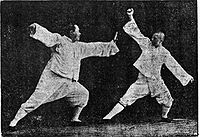As the name “tai chi chuan” is held to be derived from the Taiji symbol (Taijitu or T’ai chi t’u, ), commonly known in the West as the “yin-yang” diagram, tai chi chuan is therefore said in literature preserved in its oldest schools to be a study of yin (receptive) and yang (active) principles, using terminology found in the Chinese classics, especially the Book of Changes and the Tao Te Ching.[5]
The core training involves two primary features: the first being the solo form (ch’üan or quán, ), a slow sequence of movements which emphasize a straight spine, abdominal breathing and a natural range of motion; the second being different styles of pushing hands (tui shou, ) for training movement principles of the form in a more practical way.
The solo form should take the students through a complete, natural range of motion over their center of gravity. Accurate, repeated practice of the solo routine is said to retrain posture, encourage circulation throughout the students’ bodies, maintain flexibility through their joints and further familiarize students with the martial application sequences implied by the forms. The major traditional styles of tai chi have forms which differ somewhat cosmetically, but there are also many obvious similarities which point to their common origin. The solo forms, empty-hand and weapon, are catalogs of movements that are practiced individually in pushing hands and martial application scenarios to prepare students for self-defense training. In most traditional schools, different variations of the solo forms can be practiced: fast–slow, small circle–large circle, square–round (which are different expressions of leverage through the joints), low sitting/high sitting (the degree to which weight-bearing knees are kept bent throughout the form), for example.
The philosophy of the style is that if one uses hardness to resist violent force, then both sides are certain to be injured at least to some degree. Such injury, according to tai chi theory, is a natural consequence of meeting brute force with brute force. Instead, students are taught not to directly fight or resist an incoming force, but to meet it in softness and follow its motion while remaining in physical contact until the incoming force of attack exhausts itself or can be safely redirected, meeting yang with yin. Done correctly, this yin/yang or yang/yin balance in combat, or in a broader philosophical sense, is a primary goal of tai chi chuan training. Lao Tzu provided the archetype for this in the Tao Te Ching when he wrote, “The soft and the pliable will defeat the hard and strong.”
Tai chi’s martial aspect relies on sensitivity to the opponent’s movements and center of gravity dictating appropriate responses. Effectively affecting or “capturing” the opponent’s center of gravity immediately upon contact is trained as the primary goal of the martial tai chi student.[14] The sensitivity needed to capture the center is acquired over thousands of hours of first yin (slow, repetitive, meditative, low impact) and then later adding yang(“realistic,” active, fast, high impact) martial training; forms, pushing hands and sparring. Tai chi trains in three basic ranges, close, medium and long, and then everything in between. Pushes and open hand strikes are more common than punches, and kicks are usually to the legs and lower torso, never higher than the hip depending on style. The fingers, fists, palms, sides of the hands, wrists, forearms, elbows, shoulders, back, hips, knees and feet are commonly used to strike, with strikes to the eyes, throat, heart, groin and other acupressure points trained by advanced students. Joint traps, locks and breaks (chin na) are also used. Most tai chi teachers expect their students to thoroughly learn defensive or neutralizing skills first, and a student will have to demonstrate proficiency with them before offensive skills will be extensively trained. There is also an emphasis in the traditional schools that one is expected to show wu te (武德), martial virtue or heroism, to protect the defenseless and show mercy to one’s opponents.[15]
In addition to the physical form, martial tai chi chuan schools also focus on how the energy of a strike affects the other person. Palm strikes that physically look the same may be performed in such a way that it has a completely different effect on the target’s body. A palm strike could simply push the person forward, be focused in such a way as lift them vertically off the ground breaking their center of gravity, or terminate the force of the strike within the other person’s body with the intent of causing internal damage.
Other training exercises include:
- Weapons training and fencing applications employing the straight sword known as the jian or chien or gim (jiàn ), a heavier curved sabre, sometimes called a broadsword or tao (dāo , which is actually considered a big knife), folding fan also called san, wooden staff (2 m) known as kun (), 7 foot (2 m) spear and 13 foot (4 m) lance (both called qiāng ). More exotic weapons still used by some traditional styles are the large Dadao or Ta Tao and Pudao or P’u Tao sabres, halberd (jǐ ), cane, rope-dart, three sectional staff, Wind and fire wheels, lasso, whip, chain whip and steel whip.
- Two-person tournament sparring (as part of push hands competitions and/or sanshou );
- Breathing exercises; nei kung ( nèigōng) or, more commonly, ch’i kung ( qìgōng) to develop ch’i ( qì) or “breath energy” in coordination with physical movement and post standing or combinations of the two. These were formerly taught only to disciples as a separate, complementary training system. In the last 50 years they have become better known to the general public.
